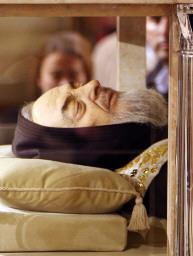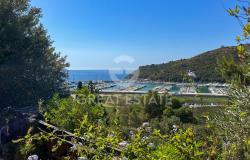An association of Padre Pio devotees said on Wednesday it wants to press charges against the Capuchin friars of San Giovanni Rotondo for allegedly desecrating the saint's tomb before the date of his official exhumation in March.
The lawyer for the Pro Padre Pio association, Francesco Traversi, said he would report the friars to police later today after a popular TV satirical news show revealed on Tuesday that the saint's tomb had been tampered with by someone taking a sneak preview at the body.
''From photographs shown, it is clear that the wax seals on the glass (of the coffin) had been altered when compared with those applied during the burial of Padre Pio,'' Traversi explained.
He said he would ask police to press criminal charges against ''the friars responsible'' as well as provincial Capuchin governor Aldo Broccato and local archbishop Domenico Umberto D'Ambrosio.
But the Capuchin friars dismissed the claims as ''fanciful'', explaining that in the days prior to the saint's burial in 1968 the wax seals had been removed from the coffin a number of times for checks on the body.
They said that after the zinc edges of the coffin were finally soldered shut, the six definitive wax seals were placed over the metal rather than the glass of the casket.
The friars also said they were considering suing people who have made ''defamatory'' claims that the remains on display to the public do not belong to the saint.
Both Pro Padre Pio and some of Padre Pio's relatives were vigorously opposed to the Catholic Church's decision to exhume the stigmata-bearing southern Italian saint in March.
Traversi, who also represents the saint's family, described the exhumation as ''profane'' and accused Monsignor D'Ambrosio of trying to ''re-crucify Padre Pio by putting his remains on display'' without any specific mandate.
But the archbishop said the exhumation had been authorised by the Vatican's Congregation for the Causes of Saints to give pilgrims a chance to venerate Padre Pio's mortal remains for the first time since he died 40 years ago.
The mystic monk was exhumed in surprisingly good condition with his beard, nails, knees and hands clearly visible.
His body went on show to the public in a glass-sided coffin on April 24 as Italian state broadcaster RAI's first channel, RAI Uno, beamed the event live across the country.
Almost 100 journalists from the international press covered the unveiling.
The saint is mainly hidden from view under a monk's habit, shoes and a lifelike silicon mask of the saint's face made by London-based specialist company Gems Studio.
Padre Pio was initially scheduled to remain on show for just a couple of months but the period was extended due to demands from millions of admirers. He will now remain in his glass-sided coffin until September 2009 before being returned to the crypt of the Santa Maria delle Grazie church in San Giovanni Rotondo, next to the friary where he spent most of his life.
SHUNNED THEN IDOLISED.
The saint, whose real name was Francesco Forgione, was born in 1887 and died in 1968. His devotees believe he bore the wounds of the crucified Christ on his hands, feet and side for at least 50 years.
By the time of his death, he was credited by his fellow friars with having performed more than a thousand miraculous cures and other miracles - one of them for the future Pope John Paul II.
Other alleged gifts were the ability to be in two places at the same time and emit the scent of fresh flowers.
Forgione was shunned by church officialdom for much of his life amid suspicions of fraud and even accusations of impropriety with female followers.
He was only belatedly recognised, largely because of his towering stature among the faithful.
Earlier this month Italian business magazine Economy reported that Padre Pio's shrine had now beaten Lourdes to become the second most popular destination for religious tourists behind the Vatican.
It is thought that the chance to venerate the saint's body will boost the number of pilgrims visiting the town from one million to around nine million a year.
The magazine put the annual turnover of the Padre Pio shrine at some 120 million euros including revenue from souvenirs, two periodicals and a satellite TV station - plus pilgrims' offerings.
A Catholic magazine once found that far more Italian Catholics pray to the Padre Pio than to Jesus or Mary.












